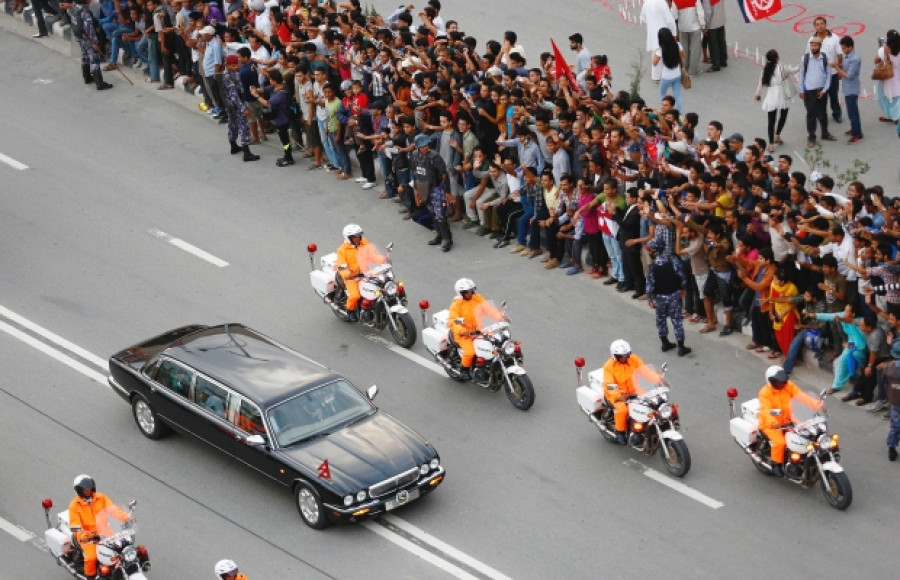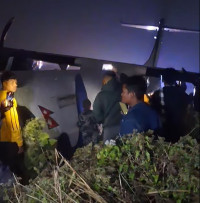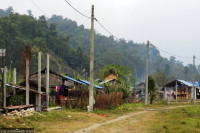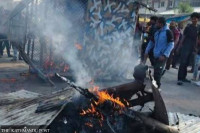National
In Nepal, a video of frustrated citizens defying roadblock for president sparks discourse over VIP convoys
Traffic obstructions like the one on Tuesday have become commonplace, leading to frustration and anger among citizens who see the roadblocks as a remnant of the ousted monarchy.
Anup Ojha
On Tuesday evening, President Bidhya Devi Bhandari was on her way to the Nepal Army headquarters in Bhadrakali from her residence in Sheetal Niwas, Maharajgunj to attend a reception marking the Nepal Army day. The traffic police, to clear her way, halted all traffic from Lainchour to Bhadrakali. Things began to take an unexpected turn when the roadblock wasn’t cleared for over 40 minutes, even as the line of waiting motorbikes and cars grew a kilometre long.
A dark shaky video that went viral on social media on Tuesday night shows what happened: frustrated with the unnecessary wait, motorbikes—their horns blaring in unison—force their way en masse through the blockade as the traffic cops watch helplessly. The video was shared over a thousand times on Twitter and Facebook, sparking discourse on the discomfort and inconveniences ordinary people have to face when VIPs like the President travel across Kathmandu.
“Traffic was obstructed for over 40 minutes. They had to wait even when President Bhandari had already left,” said Kamal Bista, a journalist for the online news portal FarakDhar.com, who took the video.
Bista was heading home from his office in Baneshwor on foot when he witnessed a fracas building and decided to take the video. First, an individual got off his bike and began to argue with the traffic police. He repeatedly asked the police to let vehicles pass as they had been waiting for too long, Bista reported to the Post.
“The argument began to get heated. The man started to shout, ‘This road belongs to the people, not the President. We made the President. This is a regular road for the public and the President’s ‘sawari’ shouldn’t obstruct us for so long.’ Then, more bikers started to blow their horns. A few started to push ahead, and other motorbikes and public vehicles began to follow. Soon, they were all moving and the traffic police were helpless,” Bista told the Post.
Bista initially took the video with the intention of putting it up as a news story for his portal. “I had never thought that this video would go viral this way. I am hopeful that this protest will rouse our authorities and make them more responsible,” said Bista.
The video was first shared by photographer Pramod Bhattarai, through his Twitter handle Chitra-Sabda (@picwrds). “The video touched my heart because this is what I face every time a VIP convoy comes through. And it happens even though there is no monarchy in the country,” said Bhattarai, who works for Freedom Forum, a non-governmental organisation that works for the institutionalisation of democracy, protection of human rights and freedom of expression. “This needs to change because this is against the mobility of commoners.”
Traffic obstructions like the one on Tuesday have become commonplace, leading to frustration and anger among citizens who see the roadblocks as a remnant of the ousted monarchy. The Nepali term ‘sawari’—meaning a royal procession—is still used, albeit ironically.
For Milan Bagale, an architect and rural development planner, the sight of VIPs speeding past in dark cars, escorted by an entire convoy of security personnel with sirens on, belies the fact that Nepal is a federal democratic republic.
“I feel like a prisoner when I can’t walk or ride,” said Bagale. “The government should look at this protest as an eye-opener.”
There are very few developed countries in the world where a head of state monopolises the streets in such a way, says Dambar Chemjong, head of the anthropology department at Tribhuvan University.
“If you look at Norway, Sweden or Spain, their heads of state are on the streets, cycling with the public. Our country has become a republic, but the thoughts of our head of state have not changed,” he said.
Chemjong says there are three primary reasons behind this obstruction of roads—either the head of state does not trust the people and feel insecure travelling freely in public; the country’s security personnel are unable to guarantee safety; or a continued feudal mindset.
At the Metropolitan Traffic Police, spokesperson Superintendent of Police Jay Raj Sapkota agreed that the situation was unfortunate, but said that the traffic police alone could not change the rules. “These security procedures are put in place by a special army force, in coordination with the Chief District Officer. Our work is simply to implement it,” said Sapkota.
Sapkota, however, attributed the length of Tuesday’s obstruction to the number of VIPs present at the Nepal Army reception. Along with President Bhandari, Prime Minister KP Sharma Oli and Vice-president Nanda Bahadur Pun were all travelling to the same event, causing an obstruction longer than usual, said SP Sapkota.
When the Post reached out to Ram Prasad Acharya, Kathmandu Chief District Officer (CDO), to inquire about Tuesday’s incident, Acharya said he was unaware of the video but that a meeting had been held on Wednesday to discuss changes in security arrangements for VIPs like the President.
“I haven’t seen the video,” said Acharya. “It was just a coincidence that a meeting was held today to discuss changes in the security plan.”
The government intends to amend the security plan, which was drafted in 2014 so that the public is not inconvenienced, he said.




 9.12°C Kathmandu
9.12°C Kathmandu.jpg)













%20(1).jpg&w=300&height=200)

